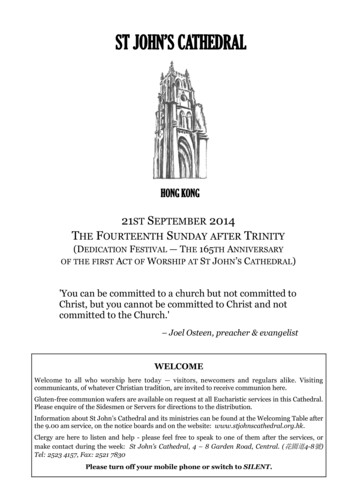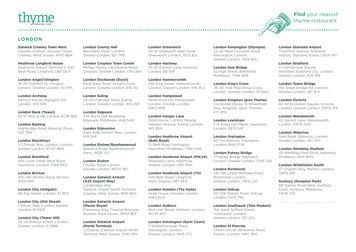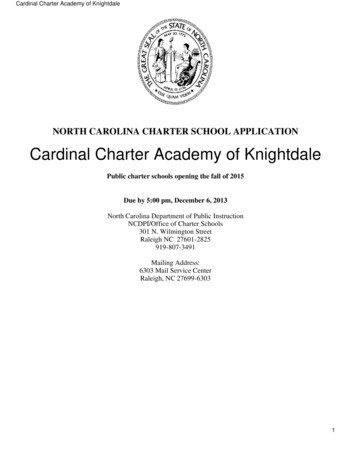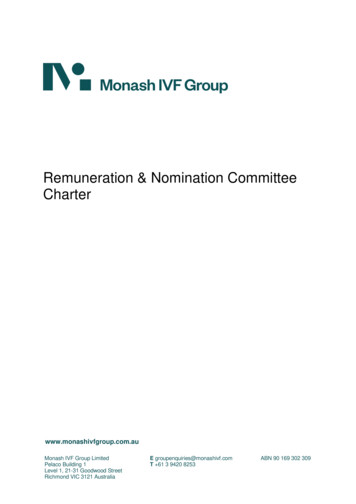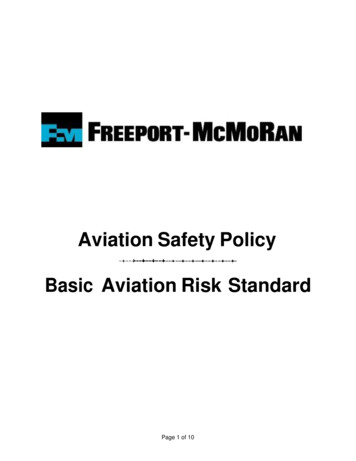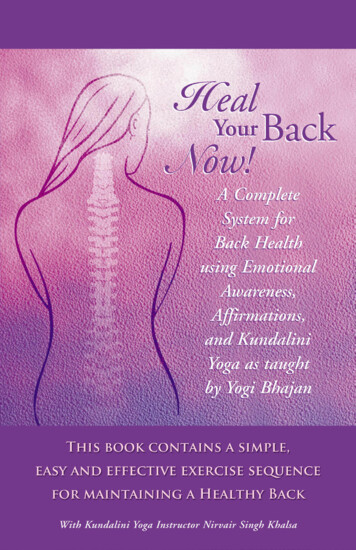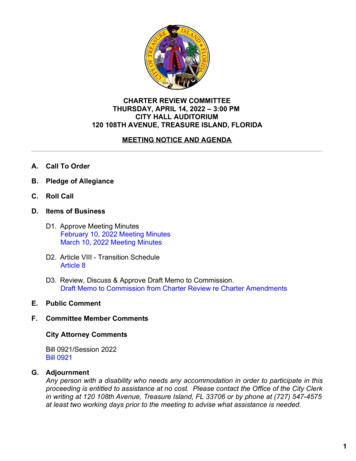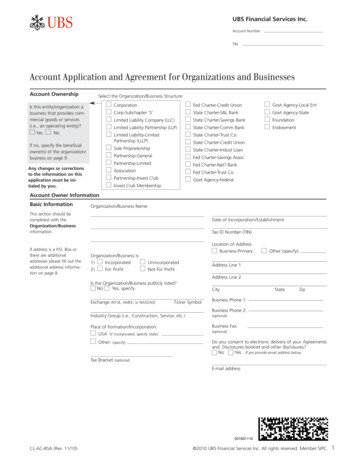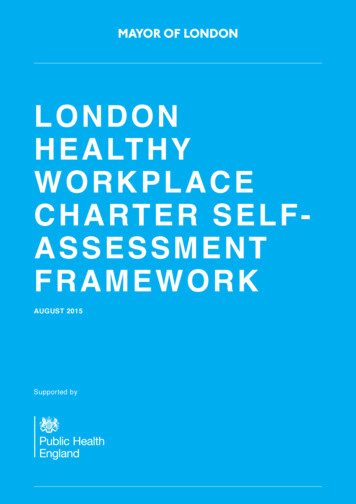
Transcription
LondonHealthyWorkplaceCharter selfassessmentframe workAUGUST 2015Supported by
L o n d on H e alt hy W o rkplace Cha r ter self-a ssessmen t fr a mewor kC o p y r i gh tGreater London AuthorityAugust 2015Greater London AuthorityCity HallThe Queen’s WalkMore LondonLondon SE1 2AAwww.london.gov.ukenquiries 020 7983 4100minicom 020 7983 4458
3LondonHealthyWorkplaceCharter selfassessmentframe workA U G U ST 2 0 1 5
L o n d on H e alt hy W o rkplace Cha r ter self-a ssessmen t fr a mewor k
5ContentsCHAPTER 1 INTRODUCTION7CHAPTER 2 commitment level11CHAPTER 3 achievement level21CHAPTER 4 excellence level27
L o n d on H e alt hy W o rkplace Cha r ter self-a ssessmen t fr a mewor k
7CHAPTER 1INTRODUCTION
L o n d on H e alt hy W o rkplace Cha r ter self-a ssessmen t fr a mewor kThe London Healthy Workplace Charterprovides a framework for action to helpemployers build good practice in healthand work in their organisation. Thecharter supports all types of employers,large and small, from the public, privateand voluntary sectors. Using this selfassessment framework your organisationcan find out what it is already doing thatfits into the ethos of the charter aswell as where it might need to improve.The framework reflects best practiceand is endorsed nationally by PublicHealth England.The business benefits of having ahealthy, fit and committed workforceare now clearly recognised. Theseinclude lower absence rates, feweraccidents, improved productivity, staffwho are engaged and committed to theorganisation and fitter employees asthey grow older. Organisations thatcommit to wellbeing can expectimproved business outcomes.By using the charter organisations canbenefit from: the ability to audit and benchmarkagainst an established andindependent set of standards –identifying what the organisationalready has in place and what gapsthere may be in the health, safety andwellbeing of employees. developing strategies and plans –the charter provides a clear structurethat organisations can use to develophealth, safety and wellbeing strategiesand plans. recognition - the award helpsto strengthen the organisation’sbrand and reputation and supportssales and marketing activities.Accredited organisations will receivea logo helping them to stand out asemployers. Representatives will alsobe invited to an exclusive awardsceremony at City Hall .Please see the ‘Accreditation Guidancefor Employers’ at www.london.gov.uk/healthyworkplace for more information.The Charter award levels:CommitmentThe entry level – for organisations that have recently started the processAchievementThe intermediate level – for organisations that have a more advanced andcomprehensive approach to employee wellbeingExcellenceThe advanced level – for organisations that demonstrate that health and wellbeingare embedded in their corporate culture and values
9The Charter standards: Corporate support for wellbeing – theways in which the organisation usesits policies and practices to create aworking environment that is conduciveto health. The section includesleadership for health, planning forhealth, equality guidance and theengagement and ownership shownby senior managers. Attendance management – the waysin which information is used to helpmanagers reduce sickness absence,inform management practice andsupport attendance. Health and safety requirements –the systems the organisationuses to monitor and improvehealth and safety. Mental health and wellbeing –the ways in which the organisationprotects and promotes the mentalwellbeing of its staff, includingappropriate policies, managementtraining and support mechanisms. Tobacco and smoking – the ways inwhich the organisation goes beyondthe minimum legal requirements. Physical activity – the ways in whichthe organisation actively promotesthe importance and benefits ofregular physical activity and createsopportunities for employees tobecome involved. Healthy eating – the ways in whichthe organisation actively encouragesand enables staff to eat healthily. Problematic use of alcohol and othersubstances – the ways in which theorganisation responds to problematicuse of alcohol and other substancesand promotes the safe and sensibleuse of alcohol.The tables in the following pagesprovide information on what meetingthe requirements might look like inaddition to suggested tools and links forfurther support. Please note that theseare examples and it is important toreflect what is most appropriate foryour organisation.
L o n d on H e alt hy W o rkplace Cha r ter self-a ssessmen t fr a mewor k
11CHAPTER 2Commitmentlevel
L o n d on H e alt hy W o rkplace Cha r ter self-a ssessmen t fr a mewor kCommitment levelCharter standardareaIs thismet?Section 1:Corporatesupportü1.1 Theorganisationhas assessedits needs andpriorities aroundhealth and workand developed anaction planWhat this might look like Supporting tools/ linksFor small businesses this maytake the form of focus groups orinformal discussions with staff,or the inclusion of health andwellbeing in team meetings. Formedium or large employers a staffsurvey may be more appropriate.Other organisational records canalso be used, such as regularsickness absence reports fromoccupational health providers.Happy People LtdA free staff survey tool to find outhow happy your staff are. HappyPeople Ltd will also summarise theresults for you.http://bit.ly/17gLXO2Evidence will refer to the reports/notes on which the needsassessment is based, togetherwith some kind of action plan toshow that it is developing activities/actions based on what its staffneed. It is also helpful to know howthe findings of surveys/ meetingsetc are communicated to staff.1.2 Yourmanagementcan demonstratethe processfor ongoingconsultation andcommunicationwith employees onrelevant workplacehealth issuesAcas – information foremployers on the EqualityAct 2010A leaflet providing detailedinformation on equality anddiscrimination within the workplace.http://bit.ly/1FSvPhLAlso see the inMethods of communicating withstaff are appropriate and theorganisation attempts to reachas many people as possible.Equality Act 2010This sets out the different waysin which it is unlawful to treatsomeone. Find out who isprotected from discrimination andthe action that can be taken.http://bit.ly/1fj9TwMAEvidence might include photos ofstaff noticeboards, screenshotsfrom the intranet to show what kindof information is provided there,copies of staff newsletters.Employee satisfaction feedbacktemplatesFind out how to keep youremployees happy and productive.http://svy.mk/1D21bSNEvidence based guidance fromNICE on workplace policy andmanagement practices Designedto improve the health andwellbeing of employees focuses onthe organizational culture and therole of line managershttp://www.nice.org.uk/guidance/ng13The NICE Local Governmentbriefing on workplace healthProvides a summary of theevidence based /Introduction
13Commitment levelCharter standardareaIs thismet?What this might look like 1.3 Seniormanagementencourages aconsistent andpositive approachto employee wellbeing throughoutthe organisationSenior management has oversightof the work that is being done andthis work is reported back to asenior level.1.4 Theorganisationis aware of itsresponsibilitiesunder the EqualityAct 2010 and otherequality legislationis known andadhered toThe organisation can describe itsresponsibilities under the EqualityAct 2010 and how these arefulfilled for example in recruitmentprocesses, working hours andflexible working etc. There isan equality and diversity policy/statement and information on thisis available to all employees.1.5 There is aneffective policy/process in placefor communicationwith staffThe organisation participates inregular meetings with all staff.Eevidence might show thatcommunication is conductedthrough a number of differentchannels (e.g. face to face, e-mail,verbal, written).Supporting tools/ linksEvidence might include notes fromsenior management meetings andstrategic documents e.g. businessplans etc which publicly statethe organisation’s commitmentto improving staff health andwellbeing.Section 2: Attendance management2.1 A clearattendancemanagementpolicy/guidanceis in place andproceduresare known toemployeesThere is an up to date absencemanagement policy/guidance.Employees are aware of theabsence management policy,for example through inductionprocesses, managementtraining, etc.2.2 Contact ismaintained withabsent employeesto provide supportand aid return toworkThe absence management policy/guidance makes it clear howimportant it is to maintain contactwith absent employees.2.3 Return towork interviewsare conductedand recordedwith concerns/appropriatesupport recordedand providedAbsence management policy/guidance includes return to workprocedures. Examples of return towork interventions are available,such as an anonymous case study.Standard forms and guidanceare available from the Health andSafety Executivehttp://bit.ly/1L4zHzaHSE managing sickness absenceand return to work in smallbusinessesShort fact sheet for smallemployers, giving advice on whatemployers should do at regularintervals of an employee’s absencefrom 3 to 28 days.http://bit.ly/1DYd7X5Standard forms andguidance – AcasProvides a useful advisory bookleton managing attendance andemployee turnover .http://bit.ly/1zZlqjH.
L o n d on H e alt hy W o rkplace Cha r ter self-a ssessmen t fr a mewor kCommitment levelCharter standardareaIs thismet?What this might look like Supporting tools/ links2.4 Specific riskassessments forindividuals areconducted andtake into accounta person’s healthstatusEvidence might include descriptiveexamples of individual riskassessments for those people withdisabilities or additional needs, andof the reasonable adjustments thathave been implemented.2.5 Reasonableadjustmentsare availableto employeesin line withrecommendationsmade in aStatement ofFitness for WorkThe absence management policy/guidance explains that reasonableadjustments are available.Evidence might include examplesof how managers understand theterm ‘reasonable adjustments’ (forexample, when giving return towork interviews).Fit for Work serviceThis Government funded initiativeis designed to support people inwork with health conditions andhelp with sickness absence. Itswebsite includes an advice hubfor employers.http://bit.ly/14d7Nk6Fit note: guidance for employersand line managersExplains what to do if an employeegives you a fit note and how youcan use it most effectively to helpyour organisation.http://bit.ly/1zijDCAEvidence based guidance onmanaging long-term sicknessand incapacity for work fromNICE http://www.nice.org.uk/guidance/ph19Including tools and resources tosupport building a business case, aguide to resources and a checklistfor managing absence Resourcesfrom NICESection 3: Health and safety3.1 Theorganisation isaware of legalobligations inrelation to healthand safety thatare relevant to theorganisationAn up to date health and safety lawposter is in place. A nominated andsufficiently competent person isresponsible for health and safety.The Scottish Healthy WorkingLives website gives details ofsome of the health and safetylegislation that apply to allemployers and workplaces, andthose extra duties that applies toworkplaces with more than fiveemployees. http://bit.ly/1rxHLfo3.2 Relevant healthand safety policiesand proceduresare in place todemonstratecompliance withhealth and safetylegislationEvidence should include theorganisation’s health and safetypolicies that reflect greatest risk aswell as information on proceduresfor staff to report incidents andaccidents.Health and Safety Executiveguidance can also be found at:http://bit.ly/1DhbZid3.3 A riskassessmentprogramme hasbeen implementedand all employeesare informed of theworkplace risksthat affect themand the controlsin placeRisk assessments are availableto all employees they have animpact on. Employees are awareof the risk assessments and knowwhere they are. Examples of riskassessments conducted in theworkplace might be includedas evidence.
15Commitment levelCharter standardareaIs thismet?What this might look like 3.4 The workplaceenvironment isconducive to healthand employeewelfare, includingdrinking water,washing facilities,clean toilets, eatingfacilities, etcThe organisation complies withthe workplace (health and safetyand welfare) regulations. Evidencecould include staff satisfactionsurveys, cleaning rotas, etc.3.5 Health andsafety training hasbeen given to allemployeesHealth and safety is detailed inthe employee induction packageand possibly included in inductiontraining.Supporting tools/ linksSection 4: Mental health4.1 Informationis provided toemployees thathelps reduce thestigma aroundmental ill-healthExamples might include describinghow the organisation talks aboutmental health to its employees(reassuring employees that mentalhealth problems are common andnot a sign of weakness). Also howthe organisation actively looks toremove barriers that would preventemployees raising mental healthissues, such as signing up to theTime to Change campaign.4.2 Informationis provided toemployees aboutmental healthand wellbeing,including workrelated stressEmployees have been giveninformation about mental healthand stress at work. Evidence mightinclude information on the intranet,training courses, leaflets, posterspromoting well-being, etc.4.3 Employeesare made awareof their legalentitlementsregarding workingconditionsEvidence might include aninduction checklist indicating thatemployees are made aware oftheir legal entitlements regardingworking conditions. Also acontract of employment statingworking conditions.4.4 Theorganisation isaware of risksrelating to workrelated stress(for example,as set out inthe Health andSafety Executive’sManagementStandards) andaction is taken toprevent it beinga problem foremployeesEvidence might include a mentalwellbeing statement/policy thatstates the HSE managementstandards for factors that influencestress. The mental wellbeingstatement/policy is available to allemployees.Tools for employersTime to ChangeThis is England’s biggestprogramme to challenge mentalhealth stigma and discrimination.Time to Change work withorganisations from all sectors toimprove policy and practice aroundmental health discrimination.http://bit.ly/1cds063HSE management standardsIdentifies six managementstandards that cover the primarysources of stress at work.http://bit.ly/1Jmvt8KEvidence based guidance fromNICE on promoting mentalwellbeing at workhttp://bit.ly/18AIAlxIncluding tools and resourcessuch as building a business case,costing tool for employers, a guideto resources, and advice for smalland medium sized sources
L o n d on H e alt hy W o rkplace Cha r ter self-a ssessmen t fr a mewor kCommitment levelCharter standardarea4.5 Employeesare aware thatmental health andwellbeing issuesare valid andpeople seekingto address theseissues are fullysupported by theorganisation atall levelsIs thismet?What this might look like Supporting tools/ linksSupportive guidance is provided toaid employees with mental healthissues. Evidence needs to showhow the employer has supportedor has the capability to supportindividuals who have issues thataffect their mental health.AcasFactors to consider if a workershows signs of stress.http://bit.ly/1G3EyBdProvides information on theimportant correlation betweenthe workplace and mental health.http://bit.ly/1IMQ0zaTools for employeesNew Economics Foundation fiveways to well-beingThe five ways to wellbeing is a setof evidence-based actions whichpromote people’s wellbeing.http://bit.ly/1cHWdOTMental Health FoundationTen practical ways on how to takecare of yourself and get the mostfrom life.http://bit.ly/1akp22XSection 5: Smoking and tobacco5.1 Theorganisation’smanagementteam is aware ofits duties undersmoke-freelegislation and isin complianceEvidence should include howmanagement is made aware ofthese duties, for example throughbriefings, training, induction, etc.5.2 All staff areaware of thesmoke-free andtobacco controllaws and howthey are appliedin their workplaceEvidence should includeinformation on where ‘Nosmoking’ signs are displayed inthe organisation (for example invehicles or the front entrance).Evidence might also includeinformation in staff code ofconduct, induction, on the staffintranet or in a relevant policy.5.3 Sources offurther informationand support toquit smoking areregularly availableEmployees have been giveninformation about the effects ofsmoking. Evidence might includeleaflets with information promotingno smoking and availability ofsupport to quit. This could beprovided on a staff noticeboard.Tools for employersGuidance on a smoke freepolicy template:Provides a free downloadablesmoke free policy template.http://bit.ly/1zZrGYREmployers who are consideringwhether to allow use of nicotinevapourisers in their policy canconsider the five questions set outby Action on Smoking and Healthin their paper, ‘Will you permit orprohibit electronic cigarette useon your premises?’ This can beaccessed here:http://bit.ly/1CAdl4KAcas also provide furtherinformation which can be foundhere: http://bit.ly/1bNb4Lg
17Commitment levelCharter standardareaIs thismet?5.4 A smoke-freepolicy is in placeand all staff areaware of it andkept informed ofany changesWhat this might look like Supporting tools/ linksEvidence should include thesmoke-free policy and an accountof how it was developed andcommunicated to staff.Evidence based guidance fromNICE on workplace interventionsDesigned to promote smokingcessation http://www.nice.org.uk/guidance/ph5 including toolsand resources such as costingtemplates for building a businesscase, and a return on investmenttool for local government. http://www.nice.org.uk/guidance/ph5/resourcesTools for employees NHS Smokefreehttp://bit.ly/19mAdEN Go Smoke Freehttp://bit.ly/1zHNR0M Smokefree NationalHelpline on 0300 123 1044 Action on Smoking and Health(ASH) http://bit.ly/1FSSjzqSection 6: Physical activity6.1 Information ismade availableon the benefits ofphysical activityEvidence might include posters/newsletters/bulletins promotingworkplace activities or sportsclubs which include the benefits ofphysical activity.6.2 The minimumlegally requiredbreaks are takenby all employeesand employees areencouraged to takeregular breaksEmployees are allowed andactively encouraged to take breaksin compliance with the WorkingTime Directive. Evidence mightinclude work schedules includingdetails of an individual’s breaks.It might also include informationgiven at induction, staff training,and training for managers.Tools for employersBritish Heart FoundationFree ideas and challenges onhow employees can remain activeat work.http://bit.ly/17bdrF3NICE guidelines on promotingphysical activity in theworkplacehttp://bit.ly/1Dhh368Promoting Physical Activityin the Workplace, BusinessCase ToolAllows organisations to calculatesavings attributed to physicalactivity in their workplacehttp://bit.ly/19oeFy6Information on Working rkingtimedirective.htm
L o n d on H e alt hy W o rkplace Cha r ter self-a ssessmen t fr a mewor kCommitment levelCharter standardareaIs thismet?What this might look like Supporting tools/ linksTfL Cycle Safety SeminarBook a free TfL Cycle SafetySeminar to promote the freeTfL one to one cycle trainingsessions to staff. To book, emailcyclingworkplaces@tfl.gov.ukwith the subject line ‘HealthyWorkplace Charter’.Tools for employersNHS ChoicesLivewell pages: Health andwellbeing informationhttp://bit.ly/1hb3NprSection 7: Healthy eating7.1 Appropriate,acceptableand accessibleinformation onhealthy eatingis providedEvidence might include leaflets,posters and other campaignmaterials. Suggestions forpromoting healthy eating includeoffering healthy snacks in staffsocial activities or starting a stafffruit bowl.7.2 Any kitchenfacilities orbeverage areas arein good conditionand conform to thehighest possiblestandards andrequirements offood hygieneWhere kitchen facilities areprovided by the employer theyare in good condition. If theorganisation provides a canteen,food hygiene certificates are inplace and there is evidence ofkitchen inspections.7.3 Whereverpossible, eatingfacilities thatare clean anduser friendlyare providedaway from workareas. Use ofthese facilities ispromoted to enableregular breaksaway from thework areaEvidence might include adescription of tea/coffee/eatingareas, cleaning rotas and feedbackfrom staff.Tools for employersBritish Heart Foundation Healthat WorkA range of resources available,including a free Think Fit pack andideas on promoting healthy eatingand well-being in the workplace.http://bit.ly/1FST0sxChange 4 Life employer packA campaign pack for employersto help encourage healthierworkspaces, including posters,challenge guides and tray liners.Register at the link below:http://bit.ly/1v5ss6fFood Standards Agency – toolkitGuidance notes for business onsafety and hygiene legislationincluding the 2006 food hygienelegislation http://bit.ly/1L4PSfXand http://bit.ly/1CAIORPHealthier and more sustainablecatering guidance – this includesa toolkit to help caterers cook andserve healthier more sustainablefood and drinks:http://bit.ly/1fYl28qLocalising the Public HealthResponsibility Deal: Toolkit forLocal AuthoritiesSets out actions which small andmedium sized businesses can taketo support their customers and
19Commitment levelCharter standardarea7.4 All workplaceshave access tofresh drinkingwaterIs thismet?What this might look like Supporting tools/ linksEvidence of this could includephotos/numbers of drinkingwater taps and the schedule ofmaintenance for them.employees to make healthierchoices: http://bit.ly/18c88FPTools for employees Eatwell plate plate.aspx Eight tips for healthy eatinghttp://bit.ly/1ms3lQO NHS Choices LivewellEvidence-based information andtips about healthy eating.http://bit.ly/1qf6OoDSection 8: Alcohol and substance misuse8.1 A workingalcohol andsubstance misusepolicy/statementis in placeregarding the useof alcohol andother substancesin the workplacethat is clear andconsistentEvidence might include astatement on alcohol andsubstance misuse in the staff codeof conduct or a relevant policy.8.2 Employeesare providedwith informationabout the effectsof alcohol andsubstance misusethat is appropriate,acceptable andaccessibleThis might include informationin employee induction packs, instaff briefings/weekly meetings orthrough a health promotion event.It could be through posters orleaflets promoting safe drinkingand availability of support.8.3 Alcohol policy/statement includesguidelines on theuse of alcohol atbusiness functionsif relevant to theorganisationEvidence might include adescription of where thisinformation exists and howit is communicated to staff.8.4 Employeesare supported inseeking help totreat alcohol orsubstance misuseissues. Thisincludes providingsources of furtherinformation andsupport that arereadily availableEvidence might include casestudies to show how employeeshave been supported in the pastand signposted to local treatmentservices.Tools for employersTackling alcohol and drugsin the workplace: a toolkitfor businessesProduced to help businessesface issues around alcohol anddrug misuse, with guidance ondeveloping a workplace alcoholpolicy. http://tinyurl.com/nqep2meHealth and Safety ExecutiveGuidance on how to deal withworkplace alcohol and drugsissues: http://bit.ly/1CAdGEoTools for employees Department of Health – ‘Yourdrinking and you’ leaflets:http://bit.ly/1Av1rLS Change4Life swap materialshttp://bit.ly/1CAdPHW
L o n d on H e alt hy W o rkplace Cha r ter self-a ssessmen t fr a mewor k
21CHAPTER 3Achievementlevel
L o n d on H e alt hy W o rkplace Cha r ter self-a ssessmen t fr a mewor kAchievement levelCharter standardareaIs thismet?Section 1:Corporatesupportü1.1 A processis in place thatrecognises andrewards good workWhat this might look like Supporting tools/ linksThis might include staff appraisals,staff reward schemes andmanagers regularly thanking theiremployees via e-mail, verbally orat team meetings.Acas – Managing staffProvides a range of freedocuments and templates to assistwith managing staff.http://bit.ly/1EZ3rILEvidence might include informationto show that appraisals areconducted regularly for all staff,information describing staffawards certificates for staff, andemails to staff recognising goodperformance.HSE Line manager competencyindicator toolTools to help line managersreflect on their own behaviour andmanagement style. http://www.hse.gov.uk/stress/mcit.htm1.2 Managersunderstand themain issues thatimpact on thehealth and wellbeing of their teamManagers meet with their staff ona regular basis and ask about theirwellbeing.1.3 Line managershave appropriatetraining forexample oncarrying outappraisals,attendancemanagement,giving performancefeedback, etcA management training programmeis in place. Guidance is providedfor line managers. Different typesof learning such as coaching andmentoring are offered.1.4 An effectivepolicy andprocedure totackle bullying andharassment hasbeen implementedEvidence might include a copyof the organisation’s bullyingand harassment policy and adescription of how this has beencommunicated to all staff.1.5 Flexibleworking practicesand family friendlypolicies arein placeRelevant policies are in place andemployees are aware of them.Evidence might include adescription of staff consultationson key health issues and agendas/minutes of training and away daysthat include staff health issues.Evidence should include copiesof policies/guidance e.g. flexibleworking, parental leave, maternityleave, bereavement policy,dependent leave, breastfeeding etcand a description of how they arecommunicated to staff, e.g. screenshot of intranet, staff handbook.Workplace bullying andharassmentBullying and harassment at workadvice for -harassmentAcas – bullying and harassmentat work guidance for employeesFurther advice on bullying andharassment at work.Acas – The right to requestflexible workingIncludes a guide to responding torequests, the right to request and ahomeworking e BlowingThe government’s guide to verviewAcas – Discipline and grievancesat workA guide for dealing with disciplineand grievances at work.http://www.acas.org.uk/index.aspx?articleid 2179
23Achievement levelCharter standardareaIs thismet?What this might look like 1.6 An effectivepolicy is in placefor whistle-blowingAll employees are able to raiseconcerns at appropriate levelsand are aware of the process todo so. The policy is supported bysenior management.1.7 Effectivepolicies are inplace to managedisciplinaryand grievanceproceduresA disciplinary and grievancepolicy is in place and is knownby all staff.Supporting tools/ linksSection 2: Attendance management2.1 Absence ratesand causes arecollected andmonitoredSenior managers are aware ofabsence rates and the maincauses. Evidence might includecompleted absence reports overa period of time with an analysisshowing the main causes.2.2 Interventionsare undertakenwhere patternsindicate trendsof absenceManagement acts when patternsof absences are identified.Employees are informed ofthe identified patterns whereanonymity can be preserved.2.3 Managershave participatedin AttendanceManagementtrainingEvidence might include copiesof training programmes, trainingattendance records and casestudies showing how training hashad a positive impact.HSE return to workquestionnaireQuestionnaire related to worklife and work life balance createdby .pdfAcas – A good practice guide formanaging bereavement in theworkplaceGuidance which helps employersmanage this difficult situationthrough appropriate and sensitivediscussions with their employeeshttp://bit.ly/1BQjq7ECruse bereavement care:Information, support and trainingon responding to bereavement inthe UMSection 3: Health and safety3.1 Systems arein place for staff toraise and resolvehealth and safetyissues3.2 All health andsafety policiesand workplaceactivities areregularly monitoredfor new hazardsand improvementsare madeEvidence might include teammeeting minutes with health andsafety on the agenda, an accident/incident book, regular meetingsbetween managers and staffon health and safety issues, asuggestions box, appraisal/keepingin touch meetings with staff.Evidence might include detailsof health and safety inspections,a health and safety policy witha completion and review date,a risk assessment with a dateand a review date (which shouldnot have expired), a completedhealth and safety checklist and/orhousekeeping checklist.HSE Risk AssessmentExample of risk assessments forbusinesses to .htmTUC guide Health and SafetyInspectionA guidance from TUC on carryingout inspections for Health andSafety reasons using a checklist /insbooklet30auglowres.pdf
L o n d on H e alt hy W o rkplace Cha r ter self-a ssessmen t fr a mewor kAchievement levelCharter standardareaIs thismet?What this might look like Supporting tools/ links4.1 Mental healthmanagementtraining is availableto help managersidentify employeeswith potentialissuesA good proportion of managershave attended mental healthawareness training. Mental healthawareness is available to allmanagers for example throughtraining courses, EAP service,promoted at induction, etc.4.2 Theorganisation hasan individualperformancereview systemin place. Thisallows employeesto comment onwork related andpersonal iss
What this might look like Supporting tools/ links 1.3 Senior management encourages a consistent and positive approach to employee well-being throughout the organisation Senior management has oversight of the work that is being done and this work is reported back to a senior level. Evidence might include notes from senior management meetings and
